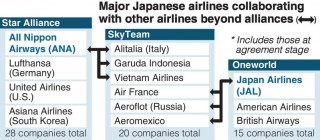Loading
Search
▼ ANA, JAL Look For Non-alliance Tie-ups
- Category:Other
All Nippon Airways Co. and Japan Airlines Co. are expanding their business tie-ups with overseas airlines beyond their respective international airline alliances.
As the industry’s competitive environment has been drastically changing due to the rise of low-cost carriers and the restructuring of major airlines worldwide, the two major airlines are employing a business strategy that does not bind them to conventional frameworks.
There are three major international airline alliances — Star Alliance, Oneworld, and SkyTeam — each formed by airline companies worldwide.
ANA, which belongs to Star Alliance, announced on March 23 that it will start code-sharing with SkyTeam member Alitalia of Italy from Oct. 28. Code-sharing will be arranged for flights not only from Narita to Milan or Rome, but also from Rome to Florence, or from Narita to Osaka. Each airline’s customers can use the other’s mileage points.
ANA does not operate direct flights to Italy. But with code-sharing, the company can expand its flight routes and expect increases in earnings as airfares will be divided by the two companies. Alitalia, for its part, expects that passengers who usually use ANA will fly on Alitalia when they travel to Italy.
ANA Executive Vice President Shuichi Fujimura expressed high hopes on the effects of the tie-up, saying, “There is still more room for foreign visitors from Italy to Japan to increase.”
ANA also has tie-ups with Vietnam Airlines and Garuda Indonesia, both of which are not members of ANA’s alliance group.
JAL, which belongs to Oneworld, has reached an agreement with SkyTeam member Aeroflot of Russia. They will start code-sharing on international flights connecting Tokyo and Moscow and domestic flights in each country from fiscal 2018 or later. JAL decided on the tie-up as visits made between Japan and Russia have been increasing after the two countries relaxed visa requirements in January 2017.
JAL has tie-ups, including those at the stage of having reached an agreement, with 15 companies that belong to other alliance groups, such as Mexican airline Aeromexico and French airline Air France.
Services such as code-sharing were conventionally arranged mainly among members of the same alliance. This was aimed at retaining customers by enhancing their convenience, including mutual use of mileage services and sharing airport facilities. There have been fierce competitive battles among alliances. However, such a structure collapsed as customers increasingly shifted to emerging low-cost carriers, which sell flight tickets for low prices. A series of mergers and acquisitions of major airlines worldwide also had an impact.
For ANA and JAL, international flight routes of all airlines within the same alliance are not necessarily promising. The situation is the same for overseas airlines. Therefore each airline is struggling for its survival and tends to seek partners with whom it could expect more profits.
As the industry’s competitive environment has been drastically changing due to the rise of low-cost carriers and the restructuring of major airlines worldwide, the two major airlines are employing a business strategy that does not bind them to conventional frameworks.
There are three major international airline alliances — Star Alliance, Oneworld, and SkyTeam — each formed by airline companies worldwide.
ANA, which belongs to Star Alliance, announced on March 23 that it will start code-sharing with SkyTeam member Alitalia of Italy from Oct. 28. Code-sharing will be arranged for flights not only from Narita to Milan or Rome, but also from Rome to Florence, or from Narita to Osaka. Each airline’s customers can use the other’s mileage points.
ANA does not operate direct flights to Italy. But with code-sharing, the company can expand its flight routes and expect increases in earnings as airfares will be divided by the two companies. Alitalia, for its part, expects that passengers who usually use ANA will fly on Alitalia when they travel to Italy.
ANA Executive Vice President Shuichi Fujimura expressed high hopes on the effects of the tie-up, saying, “There is still more room for foreign visitors from Italy to Japan to increase.”
ANA also has tie-ups with Vietnam Airlines and Garuda Indonesia, both of which are not members of ANA’s alliance group.
JAL, which belongs to Oneworld, has reached an agreement with SkyTeam member Aeroflot of Russia. They will start code-sharing on international flights connecting Tokyo and Moscow and domestic flights in each country from fiscal 2018 or later. JAL decided on the tie-up as visits made between Japan and Russia have been increasing after the two countries relaxed visa requirements in January 2017.
JAL has tie-ups, including those at the stage of having reached an agreement, with 15 companies that belong to other alliance groups, such as Mexican airline Aeromexico and French airline Air France.
Services such as code-sharing were conventionally arranged mainly among members of the same alliance. This was aimed at retaining customers by enhancing their convenience, including mutual use of mileage services and sharing airport facilities. There have been fierce competitive battles among alliances. However, such a structure collapsed as customers increasingly shifted to emerging low-cost carriers, which sell flight tickets for low prices. A series of mergers and acquisitions of major airlines worldwide also had an impact.
For ANA and JAL, international flight routes of all airlines within the same alliance are not necessarily promising. The situation is the same for overseas airlines. Therefore each airline is struggling for its survival and tends to seek partners with whom it could expect more profits.
- April 2, 2018
- Comment (0)
- Trackback(0)


